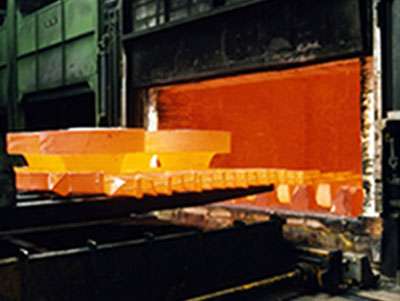Annealing is the treatment of a metal or alloy by heating to a predetermined temperature and then cooling to room temperature. Annealing improves ductility and reduces brittleness. IST anneals in a controlled atmosphere to avoid surface scaling.
Normalizing is the treatment of a metal or alloy by heating to a predetermined temperature above the material’s transformation temperature and then controlled cooling to well below the transformation range. Normalizing provides grain refinement and uniformity. IST normalizes in a controlled atmosphere to avoid surface scaling.
Stress Relieving is the treatment of a metal or alloy by heating to a predetermined temperature below its lower transformation temperature followed by cooling in air. The primary purpose is to relieve stresses that have been absorbed by the metal from processes such as forming, straightening, machining or rolling.


View all of Our ServicesRequest a Quote Today
Annealing/Normalizing/Stress Relieving Capabilities
Part Length Range
0.25 mm to 762 mm
Loading Methods
Bulk Loading
Rack Loading
Facilities
Furnace size up to 36″ x 72″ x 36″, load size up to 6000 pounds
Continuous belt systems (2)
Data log heat treat attributes
Integral pre- and post-washing systems
Slow cool in protective atmosphere
Customer Process Specifications
Caterpillar 1E1042
Chrysler PS-4
Clark Components International (5X- )
Ford W-HTX-14, W-HT1-15
Trained/Competent Workforce
To attain operational excellence, IST fosters employee development by diversifying employee’s capabilities, enhancing skill sets and creating a climate for action. Cross-trained employees understand all aspects of the heat treat process, and our customer’s needs. Certified employees are capable of receiving, heat treating, inspecting and shipping.
Technology and Knowledge Management
To best manage our customer’s needs, IST continually refines the knowledge management process and improves information technology resources. We utilize best practices to facilitate the transfer of knowledge to all levels of the organization; employees understand our customer’s requirements and act in their best interests.
 Stress relieving
Stress relieving
Stress relieving is carried out on metal products in order to minimise residual stresses in the structure thereby reducing the risk of dimensional changes during further manufacturing or final use of the component.
Benefits
Machining, and cutting, as well as plastic deformation, will cause a build up of stresses in a material. These stresses could cause unwanted dimension changes if released uncontrolled, for example during a subsequent heat treatment. To minimise stresses after machining and the risk for dimension changes the component can be stress relieved.
Stress relieving is normally done after rough machining, but before final finishing such as polishing or grinding.
Parts that have tight dimensional tolerances, and are going to be further processed, for example by nitrocarburising, must be stress relieved.
Welded structures can be made tension free by stress relieving.
Application & materials
Stress relieving does not change the material’s structure and does not significantly affect its hardness.
Hardened and tempered parts to be stress relieved must be treated at a temperature around 50°C below the temperature used for previous tempering to avoid an impact on the hardness.
Stress relieving before nitrocarburising should be executed at temperatures >600°C.
Copper and brass components can also be stress relieved. For stainless steels a high temperature solution heat treatment is normally necessary.
Process details
The stress relieving temperature is normally between 550 and 650°C for steel parts. Soaking time is about one to two hours. After the soaking time the components should be cooled down slowly in the furnace or in air. A slow cooling speed is important to avoid tensions caused by temperature differences in the material, this is especially important when stress relieving larger components.
If necessary, stress relieving can be performed in a furnace with protective gas, to protect surfaces from oxidation. In extreme conditions vacuum furnaces can be used.
The temperature for stress relieving copper parts is, depending on the alloy, 150-275°C and for brass components 250-500°C.

Stress relieving is a form of post weld heat treatment. In stress relieving we heat a material to a specific temperature; hold it at this temperature for a specified amount of time in order to reduce or eliminate residual stresses; and then cool it at a slow enough rate to prevent these stresses from redeveloping.
In most cases, stress relieving is done to regain dimensional tolerance and to reduce distortion. Distortion occurs due to the rapid and uneven heating and cooling of the weld metal and the surrounding base metal. As the molten weld metal cools it contracts and does so at a different rate than the base metal around it.
When this happens, if the part is restrained we will have residual stresses. Essentially the weld will be in tension. If the part is not restrained we will end up with distortion. More often than not you will have a combination of both.
As the image above shows, in the case of a butt joint, as the weld cools it shrinks and pulls the adjacent base material towards the center of the weld. It pulls the top closer because there is more weld metal towards to the top of the joint. If the weld was made from the bottom the angular distortion would be in the opposite direction.
In this particular case we have low residual stresses since the base metal was free to move and accommodate the contraction of the weld as it cooled.
When the part is restrained and the adjacent base metal is not free to move, we end up with residual stresses as can be seen below.
The members being joined may be restrained by clamps. They may be restrained by having their opposite ends welded to other members. They may be restrained by the joint configuration such as a circumferential joint as the one seen when welding pipe. The restraint may also come from the sheer mass of the part such as those seen in jumbo shape components.
When the base metal adjacent to the weld is not free to move something has to give. That something is the weld. The restrained pieces are essentially trying to tear the weld in half by pulling on it from opposite directions. This creates a situation where the weld remainsunder a tensile load. This is residual stress. Residual stresses are typically of the same magnitude as the yield strength of the base material. They are not desired because they can cause premature failure of manufactured products. They also reduce the load capacity of welded connections. Residual stresses can also speed up the damage caused by fatigue and creep.

We stress relieve to reduce residual stresses. By uniformly heating the part to the stress relieving temperature and holding it for a specified amount of time, we allow the residual stress to be lowered.
The temperature to which we heat a part for stress relieving must be below the material’s transformation temperature. For ferritic steels, this transformation temperature is around 1350˚F [730˚C]. For most steels, the stress relieving temperature will be around 1100-1200˚F [600 – 650˚C]. Certain steels may require higher temperatures.
One very important aspect of stress relieving that is often times missed is that the weld must be allowed to cool down to room temperature before stress relieving. If the weld is not allowed to cool and we perform stress relieving we will end up with the residual stresses we were trying to avoid.
Once the part is cooled to room temperature, stress relieving can begin by heating the part uniformly. The heating rate must not exceed 400˚F per hour, but in most cases it will be slower.
Holding times are typically calculated by the thickness of the material. One hour at the holding temperature per inch [25mm] of thickness of the thickest member being joined.
The part must then be cooled uniformly at a controlled rate to avoid residual stress from returning. Cooling rates are dictated by codes or other specifications. Typically we do not want to exceed a cooling rate of 400˚F [205˚C] per hour. To achieve this slow rate of cooling the part must be allowed to cool in the furnace. Once the part reaches 600˚F [315˚C] it can be cooled down to room temperature in air.
Always consult the code you are working with for specific instructions on how to stress relieve the materials you are working with.
References:
The Procedure Handbook of Arc Welding – 14th Edition
Metals and How to Weld Them
AWS D1.1/D1.1M:2015 Structural Welding Code – Steel
Stress Relieving – A definition
Stress Relieving consists of heating the steel to a temperature below the critical range to relieve the stresses resulting from cold working, shearing, or gas cutting. It is not intended to alter the microstructure or mechanical properties significantly.also a process for making material softer.
 Stress relief and post weld heat treatment
Stress relief and post weld heat treatment
However stress relieving does not change the material properties as does annealing and normalizing. A material can be stress relieved by heating it to a specific temperature that is lower than that of annealing or normalizing and letting it cool to room temperature inside or outside of the oven. This heat treatment is typically used on parts that have been severely stressed during fabrication.

Stress relieving is done by subjecting the parts to a temperature of about 75 ºC (165 ºF) below the transformation temperature,line A1 on the diagram, which is about 727 ºC (1340 ºF) of steel—thus stress relieving is done at about 650 ºC (1202 ºF) for about one hour or till the whole part reaches the temperature. This removes more than 90% of the internal stresses. Alloy steels are stress relieved at higher temperatures. After removing from the furnace, the parts are air cooled in still air.

As the name implies, the purpose of this process is to remove internal residual stresses from steels. The stresses may have come from the steel making mills, machining, forming, welding etc.
If residual stresses are not removed prior to hardening, distortion may occur, whilst if stresses are left in components before they go into service, then premature failures can result, as well as more subtle movement causing the parts to go out of tolerance.
To Stress relieve steels, heat the parts to a temperature of about 650ºC for a minimum of one hour or till the whole part reaches the temperature. This will remove most of the internal stresses. After removing from the furnace, they are air cooled in still air.
Typical parts that benefit from stress relieving are large and complex welded assemblies, castings with a lot of machining, parts with tight dimensional tolerances and machined parts that have had a lot of stock removal or rapid stock removal.
 Stress Relieving Furnace
Stress Relieving Furnace
It is worth noting that many heat treatments and welding processes cause stresses in the material that can lead to warpage either after the heat treating process or during subsequent machining operations. Of specific concern is the stress induced by welding. If a weldment is to be machined it should almost always be stress relieved or normalized before the machining process. This is because machining chunks of material from a stressed weldment redistributes the internal stresses and can cause the part to warp. If the stresses are first relaxed then abrupt changes in geometry after machining are reduced.
Machining induces stresses in parts. The bigger and more complex the part, the more the stresses. These stresses can cause distortions in the part long term. If the parts are clamped in service, then cracking could occur. Also hole locations can change causing them to go out of tolerance. For these reasons, stress relieving is often necessary.
Typically, the parts that benefit from stress relieving are large and complex weldments, castings with a lot of machining, parts with tight dimensional tolerances and machined parts that have had a lot of stock removal performed.




